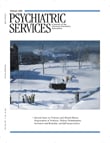February 2008: This Month's Highlights
Special Issue on Violence and Mental Illness
Does having a mental illness make a person more likely to commit a violent act? Intense media coverage of incidents such as the April 2007 shootings at Virginia Tech often leads the public to make a direct link—mental illness equals violence. However, more than a decade of research has shown that the equation is not as straightforward. In a commentary, Editor Howard H. Goldman notes that the mental health field is "concerned about the recovery of individuals diagnosed as having a mental disorder, and we must protect them from harm. But we also have an obligation to protect society from dangers that might be associated with mental illness …. It is imperative that we get the balance right" ( Original article: page 135 ). This special issue examines several aspects of violence among individuals with mental illness in order to come to a more nuanced view.
The MacArthur Violence Risk Assessment Study Revisited
The lead article takes the form of a debate. E. Fuller Torrey, M.D., and Jonathan Stanley, J.D., challenge the main conclusion of the MacArthur Violence Risk Assessment Study, and that study's authors, led by John Monahan, Ph.D., and Henry J. Steadman, Ph.D., respond. The findings, first published in 1998, indicated that the link between mental illness and violence is indirect: people with mental disorders are more likely than others to abuse substances, and people who abuse substances are much more likely than people who do not to engage in violence. Dr. Torrey and Mr. Stanley point out that in the MacArthur sample of 951 psychiatric patients, three patients killed six people—a rate much higher than the homicide rate in the general population. Dr. Monahan and Dr. Steadman respond that selecting a few cases is not a systematic assessment of rates. They also respond to several critiques about the MacArthur Study's design, standing by the study's conclusions ( Original article: page 147 ).
Violence Perpetration and Violent Victimization
In the second article, a research group led by Linda A Teplin, Ph.D., reviews 31 U.S. research studies published since 1990. These studies reported violence rates among psychiatric patients—including violence perpetrated by the patients (31 studies) and violence that they experienced as victims of crime (ten studies). Among outpatients, 2% to 13% reported committing a violent act; rates varied depending on the time period examined. However, 20% to 34% reported being a victim of violent crime. Dr. Teplin and colleagues found that violence perpetration among inpatients was higher, especially in the weeks before involuntary commitment (17% to 50%). The authors conclude that their results do not support the stereotype that persons with severe mental illness are typically violent, and they note that the heavy research focus on perpetration has masked evidence of the susceptibility to violent victimization in this population ( Original article: page 153 ).
Predicting and Preventing Violence
The ability of clinicians to identify patients who are likely to be violent has improved over the past 30 years, according to an article by Alec Buchanan, Ph.D., M.D., who examined statistical approaches to prediction ( Original article: page 184 ). Identified risk factors have been incorporated into screening interviews. However, the accuracy of even the best screen is substantially below what would be considered acceptable in other areas of medicine, notes Jeffrey W. Swanson, Ph.D., in an Open Forum ( Original article: page 191 ). Using currently available screening tests, clinicians would end up having to hospitalize large numbers of people to prevent violence among a few. Both authors are hopeful that routine use of screens and ongoing research into risk factors will improve clinicians' ability to prevent violence.
Briefly Noted …
• A study of veterans with mental illness by Steven K. Erickson, LL.M., Ph.D., and colleagues found that substance abuse was the primary risk factor for jail incarceration ( Original article: page 178 ).
• An Open Forum by Janice LeBel, Ed.D., raises concerns about patient abuses that might arise from 2007 changes in the federal regulations governing seclusion and restraint ( Original article: page 194 ), and a commentary by Steven S. Sharfstein, M.D., provides a hospital administrator's view ( Original article: page 197 ).
A brief report from the Netherlands by Eline Veltkamp, M.Sc., and colleagues suggests that inpatients would prefer to be asked about their preference for seclusion or forced medication ( Original article: page 209 ), and a commentary by Robert Bernstein, Ph.D., argues that this research "presents a false dilemma in seeking patients' preferences between two risky options" ( Original article: page 212 ).



